One Dimensional AuAg Nanostructures as Anodic Catalysts in the Ethylene Glycol Oxidation
Abstract
1. Introduction
2. Materials and Methods
2.1. Materials
2.2. Characterisation Techniques
2.3. Synthesis and Characterisation of 1D AuAg Nanostructures
2.4. Synthesis and Ultrathin AuAg Nanowires as Anodic Catalysts for Ethylene Glycol Oxidation
3. Results and Discussion
3.1. Synthesis and Characterisation of 1D AuAg Nanostructures
3.2. Electro-oxidation of Ethylene Glycol Using Selected AuAg 1D Nanostructures as Anodic Catalysts
4. Conclusions
Supplementary Materials
Author Contributions
Funding
Acknowledgments
Conflicts of Interest
References
- Zhao, X.; Yin, M.; Ma, L.; Liang, L.; Liu, C.; Liao, J.; Lu, T.; Xing, W. Recent advances in catalysts for direct methanol fuel cells. Energy Environ. Sci. 2011, 4, 2736. [Google Scholar] [CrossRef]
- Farrell, A.E.; Plevin, R.J.; Turner, B.T.; Jones, A.D.; O’hare, M.; Kammen, D.M. Ethanol can contribute to energy and environmental goals. Science 2006, 311, 506–509. [Google Scholar] [CrossRef] [PubMed]
- Wang, Y.; Zou, S.; Cai, W.-B. Recent Advances on Electro-Oxidation of Ethanol on Pt- and Pd-Based Catalysts: From Reaction Mechanisms to Catalytic Materials. Catalysts 2015, 5, 1507–1534. [Google Scholar] [CrossRef]
- Tamaki, T.; Yamauchi, A.; Ito, T.; Ohashi, H.; Yamaguchi, T. The effect of methanol crossover on the cathode overpotential of DMFCs. Fuel Cells 2011, 11, 394–403. [Google Scholar] [CrossRef]
- Pethaiah, S.S.; Arunkumar, J.; Ramos, M.; Al-Jumaily, A.; Manivannan, N. The impact of anode design on fuel crossover of direct ethanol fuel cell. Bull. Mater. Sci. 2016, 39, 273–278. [Google Scholar] [CrossRef]
- Gurau, B.; Smotkin, E.S. Methanol crossover in direct methanol fuel cells: A link between power and energy density. J. Power Sources 2002, 112, 339–352. [Google Scholar] [CrossRef]
- Andreadis, G.; Tsiakaras, P. Ethanol crossover and direct ethanol PEM fuel cell performance modeling and experimental validation. Chem. Eng. Sci. 2006, 61, 7497–7508. [Google Scholar] [CrossRef]
- Serov, A.; Kwak, C. Recent achievements in direct ethylene glycol fuel cells (DEGFC). Appl. Catal. B Environ. 2010, 97, 1–12. [Google Scholar] [CrossRef]
- An, L.; Zhao, T.S.; Shen, S.Y.; Wu, Q.X.; Chen, R. Performance of a direct ethylene glycol fuel cell with an anion-exchange membrane. Int. J. Hydrog. Energy 2010, 35, 4329–4335. [Google Scholar] [CrossRef]
- Matsuoka, K.; Iriyama, Y.; Abe, T.; Matsuoka, M.; Ogumi, Z. Electrocatalytic Oxidation of Ethylene Glycol in Alkaline Solution. J. Electrochem. Soc. 2005, 152, A729. [Google Scholar] [CrossRef]
- An, L.; Chen, R. Recent progress in alkaline direct ethylene glycol fuel cells for sustainable energy production. J. Power Sources 2016, 329, 484–501. [Google Scholar] [CrossRef]
- Wang, H.; Jusys, Z.; Behm, R.J. Electrochemical oxidation kinetics and mechanism of ethylene glycol on a carbon supported Pt catalyst: A quantitative DEMS study. J. Electroanal. Chem. 2006, 595, 23–36. [Google Scholar] [CrossRef]
- Demirci, U.B. Theoretical means for searching bimetallic alloys as anode electrocatalysts for direct liquid-feed fuel cells. J. Power Sources 2007, 173, 11–18. [Google Scholar] [CrossRef]
- Sun, X.; Gao, K.; Pang, X.; Yang, H.; Volinsky, A.A. Electrochemical Oxidation of Methanol on Pt-SnOx/C Catalysts Characterized by Electrochemistry Methods. J. Electrochem. Soc. 2015, 162, F1540–F1548. [Google Scholar] [CrossRef]
- Meng, H.-B.; Zhang, X.-F.; Pu, Y.-L.; Chen, X.-L.; Feng, J.-J.; Han, D.-M.; Wang, A.-J. One-pot solvothermal synthesis of reduced graphene oxide-supported uniform PtCo nanocrystals for efficient and robust electrocatalysis. J. Colloid Interface Sci. 2019, 543, 17–24. [Google Scholar] [CrossRef]
- Shi, Y.-C.; Feng, J.-J.; Lin, X.-X.; Zhang, L.; Yuan, J.; Zhang, Q.-L.; Wang, A.-J. One-step hydrothermal synthesis of three-dimensional nitrogen-doped reduced graphene oxide hydrogels anchored PtPd alloyed nanoparticles for ethylene glycol oxidation and hydrogen evolution reactions. Electrochim. Acta 2019, 293, 504–513. [Google Scholar] [CrossRef]
- Li, Y.F.; Lv, J.J.; Wang, A.J.; Zhang, M.; Wang, R.Z.; Feng, J.J. l-Arginine-assisted electrochemical fabrication of hierarchical gold dendrites with improved electrocatalytic activity. J. Solid State Electrochem. 2015, 19, 3185–3193. [Google Scholar] [CrossRef]
- Xu, H.; Ren, F.; Yan, B.; Wang, J.; Li, S.; Du, Y. Superior liquid fuel oxidation electrocatalysis enabled by novel one-dimensional AuM (M = Pt, Pd) nanowires. J. Electroanal. Chem. 2018, 811, 37–45. [Google Scholar] [CrossRef]
- Xu, H.; Yan, B.; Li, S.; Wang, J.; Song, P.; Wang, C.; Guo, J.; Du, Y. Highly open bowl-like PtAuAg nanocages as robust electrocatalysts towards ethylene glycol oxidation. J. Power Sources 2018, 384, 42–47. [Google Scholar] [CrossRef]
- Xu, H.; Wang, J.; Yan, B.; Li, S.; Wang, C.; Shiraishi, Y.; Yang, P.; Du, Y. Facile construction of fascinating trimetallic PdAuAg nanocages with exceptional ethylene glycol and glycerol oxidation activity. Nanoscale 2017, 9, 17004–17012. [Google Scholar] [CrossRef]
- Xu, H.; Yan, B.; Wang, J.; Zhang, K.; Li, S.; Xiong, Z.; Wang, C.; Shiraishi, Y.; Du, Y.; Yang, P. Self-supported porous 2D AuCu triangular nanoprisms as model electrocatalysts for ethylene glycol and glycerol oxidation. J. Mater. Chem. A 2017, 5, 15932–15939. [Google Scholar] [CrossRef]
- Xu, H.; Yan, B.; Zhang, K.; Wang, J.; Li, S.; Wang, C.; Xiong, Z.; Shiraishi, Y.; Du, Y. Self-Supported Worm-like PdAg Nanoflowers as Efficient Electrocatalysts towards Ethylene Glycol Oxidation. ChemElectroChem 2017, 4, 2527–2534. [Google Scholar] [CrossRef]
- Yang, Z.-Z.; Liu, L.; Wang, A.-J.; Yuan, J.; Feng, J.-J.; Xu, Q.-Q. Simple wet-chemical strategy for large-scaled synthesis of snowflake-like PdAu alloy nanostructures as effective electrocatalysts of ethanol and ethylene glycol oxidation. Int. J. Hydrog. Energy 2017, 42, 2034–2044. [Google Scholar] [CrossRef]
- Li, A.; Chen, Y.; Duan, W.; Wang, C.; Zhuo, K. Shape-controlled electrochemical synthesis of Au nanocrystals in reline: Control conditions and electrocatalytic oxidation of ethylene glycol. RSC Adv. 2017, 7, 19694–19700. [Google Scholar] [CrossRef]
- Xin, L.; Zhang, Z.; Qi, J.; Chadderdon, D.; Li, W. Electrocatalytic oxidation of ethylene glycol (EG) on supported Pt and Au catalysts in alkaline media: Reaction pathway investigation in three-electrode cell and fuel cell reactors. Appl. Catal. B Environ. 2012, 125, 85–94. [Google Scholar] [CrossRef]
- Hong, W.; Wang, J.; Wang, E. Facile synthesis of highly active PdAu nanowire networks as self-supported electrocatalyst for ethanol electrooxidation. ACS Appl. Mater. Interfaces 2014, 6, 9481–9487. [Google Scholar] [CrossRef]
- Cai, K.; Liao, Y.; Zhang, H.; Liu, J.; Lu, Z.; Huang, Z.; Chen, S.; Han, H. Controlled Synthesis of Au-Island-Covered Pd Nanotubes with Abundant Heterojunction Interfaces for Enhanced Electrooxidation of Alcohol. ACS Appl. Mater. Interfaces 2016, 8, 12792–12797. [Google Scholar] [CrossRef]
- Ottoni, C.A.; da Silva, S.G.; De Souza, R.F.B.; Neto, A.O. Glycerol oxidation reaction using PdAu/C electrocatalysts. Ionics 2016, 22, 1167–1175. [Google Scholar] [CrossRef]
- Xu, H.; Yan, B.; Zhang, K.; Wang, C.; Zhong, J.; Li, S.; Du, Y.; Yang, P. PVP-stabilized PdAu nanowire networks prepared in different solvents endowed with high electrocatalytic activities for the oxidation of ethylene glycol and isopropanol. Colloids Surf. A Physicochem. Eng. Asp. 2017, 522, 335–345. [Google Scholar] [CrossRef]
- Yang, W.; Zhang, Q.; Peng, C.; Wu, E.; Chen, S.; Ma, Y.; Hou, J.; He, Y.; Zhang, B.; Deng, L. Au@PdAg core–shell nanotubes as advanced electrocatalysts for methanol electrooxidation in alkaline media. RSC Adv. 2019, 9, 931–939. [Google Scholar] [CrossRef]
- Lv, H.; Wang, Y.; Lopes, A.; Xu, D.; Liu, B. Ultrathin PdAg single-crystalline nanowires enhance ethanol oxidation electrocatalysis. Appl. Catal. B Environ. 2019, 249, 116–125. [Google Scholar] [CrossRef]
- Jiang, K.; Bu, L.; Wang, P.; Guo, S.; Huang, X. Trimetallic PtSnRh Wavy Nanowires as Efficient Nanoelectrocatalysts for Alcohol Electrooxidation. ACS Appl. Mater. Interfaces 2015, 7, 15061–15067. [Google Scholar] [CrossRef]
- Jiang, X.; Fu, G.; Wu, X.; Liu, Y.; Zhang, M.; Sun, D.; Xu, L.; Tang, Y. Ultrathin AgPt alloy nanowires as a high-performance electrocatalyst for formic acid oxidation. Nano Res. 2018, 11, 499–510. [Google Scholar] [CrossRef]
- Wang, Y.; Choi, S.I.; Zhao, X.; Xie, S.; Peng, H.C.; Chi, M.; Huang, C.Z.; Xia, Y. Polyol synthesis of ultrathin Pd nanowires via attachment-based growth and their enhanced activity towards formic acid oxidation. Adv. Funct. Mater. 2014, 24, 131–139. [Google Scholar] [CrossRef]
- Pei, J.; Mao, J.; Liang, X.; Zhuang, Z.; Chen, C.; Peng, Q.; Wang, D.; Li, Y. Ultrathin Pt-Zn Nanowires: High-Performance Catalysts for Electrooxidation of Methanol and Formic Acid. ACS Sustain. Chem. Eng. 2018, 6, 77–81. [Google Scholar] [CrossRef]
- Guo, S.; Zhang, S.; Sun, X.; Sun, S. Synthesis of Ultrathin FePtPd Nanowires and Their Catalysis for Methanol Oxidation Reaction. J. Am. Chem. Soc. 2011, 133, 15354–15357. [Google Scholar] [CrossRef]
- Mao, J.; Chen, W.; He, D.; Wan, J.; Pei, J.; Dong, J.; Wang, Y.; An, P.; Jin, Z.; Xing, W.; et al. Design of ultrathin Pt-Mo-Ni nanowire catalysts for ethanol electrooxidation. Sci. Adv. 2017, 3, e1603068. [Google Scholar] [CrossRef]
- Hong, W.; Wang, J.; Wang, E. Facile synthesis of PtCu nanowires with enhanced electrocatalytic activity. Nano Res. 2015, 8, 2308–2316. [Google Scholar] [CrossRef]
- Hong, W.; Wang, J.; Wang, E. Facile synthesis of PdAgTe nanowires with superior electrocatalytic activity. J. Power Sources 2014, 272, 940–945. [Google Scholar] [CrossRef]
- Liang, H.-W.; Liu, S.; Gong, J.-Y.; Wang, S.-B.; Wang, L.; Yu, S.-H. Ultrathin Te Nanowires: An Excellent Platform for Controlled Synthesis of Ultrathin Platinum and Palladium Nanowires/Nanotubes with Very High Aspect Ratio. Adv. Mater. 2009, 21, 1850–1854. [Google Scholar] [CrossRef]
- Subramanian, P.; Meziane, D.; Wojcieszak, R.; Dumeignil, F.; Boukherroub, R.; Szunerits, S. Plasmon-Induced Electrocatalysis with Multi-Component Nanostructures. Materials 2018, 12, 43. [Google Scholar] [CrossRef]
- Xu, H.; Yan, B.; Yang, J.; Li, S.; Wang, J.; Du, Y.; Ren, F. Exceptional ethylene glycol electrooxidation activity enabled by sub-16 nm dendritic Pt–Cu nanocrystals catalysts. Int. J. Hydrog. Energy 2018, 43, 1489–1496. [Google Scholar] [CrossRef]
- Rasmussen, M.; Serov, A.; Artyushkova, K.; Chen, D.; Rose, T.C.; Atanassov, P.; Harris, J.M.; Minteer, S.D. Enhancement of Electrocatalytic Oxidation of Glycerol by Plasmonics. ChemElectroChem 2019, 6, 241–245. [Google Scholar] [CrossRef]
- Xu, H.; Song, P.; Fernandez, C.; Wang, J.; Shiraishi, Y.; Wang, C.; Du, Y. Surface plasmon enhanced ethylene glycol electrooxidation based on hollow platinum-silver nanodendrites structures. J. Taiwan Inst. Chem. Eng. 2018, 91, 316–322. [Google Scholar] [CrossRef]
- Xu, H.; Song, P.; Wang, J.; Shiraishi, Y.; Du, Y.; Liu, Q. Visible-Light-Driven 3D Dendritic PtAu@Pt Core–Shell Photocatalyst toward Liquid Fuel Electrooxidation. ACS Sustain. Chem. Eng. 2018, 6, 7159–7167. [Google Scholar] [CrossRef]
- Hong, X.; Tan, C.; Liu, J.; Yang, J.; Wu, X.-J.; Fan, Z.; Luo, Z.; Chen, J.; Zhang, X.; Chen, B.; et al. AuAg Nanosheets Assembled from Ultrathin AuAg Nanowires. J. Am. Chem. Soc. 2015, 137, 1444–1447. [Google Scholar] [CrossRef]
- Gong, S.; Schwalb, W.; Wang, Y.; Chen, Y.; Tang, Y.; Si, J.; Shirinzadeh, B.; Cheng, W. A wearable and highly sensitive pressure sensor with ultrathin gold nanowires. Nat. Commun. 2014, 5, 3132. [Google Scholar] [CrossRef]
- Cui, H.; Hong, C.; Ying, A.; Yang, X.; Ren, S. Ultrathin Gold Nanowire-Functionalized Carbon Nanotubes for Hybrid Molecular Sensing. ACS Nano 2013, 7, 7805–7811. [Google Scholar] [CrossRef]
- Wang, C.; Hu, Y.; Lieber, C.M.; Sun, S. Ultrathin Au Nanowires and Their Transport Properties. J. Am. Chem. Soc. 2008, 130, 8902–8903. [Google Scholar] [CrossRef]
- Pazos-Pérez, N.; Baranov, D.; Irsen, S.; Hilgendorff, M.; Liz-Marzán, L.M.; Giersig, M. Synthesis of flexible, ultrathin gold nanowires in organic media. Langmuir 2008, 24, 9855–9860. [Google Scholar] [CrossRef]
- Song, P.; Xu, H.; Wang, J.; Shiraishi, Y.; Du, Y. Construct 3D networked Au-Cu nanowires for enhanced plasmon-driven catalytic ethylene glycol oxidation through visible light irradiation. J. Power Sources 2018, 399, 59–65. [Google Scholar] [CrossRef]
- Reguera, J.; Langer, J.; Jiménez de Aberasturi, D.; Liz-Marzán, L.M. Anisotropic metal nanoparticles for surface enhanced Raman scattering. Chem. Soc. Rev. 2017, 46, 3866–3885. [Google Scholar] [CrossRef]
- Cui, X.; Qin, F.; Ruan, Q.; Zhuo, X.; Wang, J. Circular Gold Nanodisks with Synthetically Tunable Diameters and Thicknesses. Adv. Funct. Mater. 2018, 28, 1705516. [Google Scholar] [CrossRef]
- Loiseau, A.; Asila, V.; Boitel-Aullen, G.; Lam, M.; Salmain, M.; Boujday, S. Silver-Based Plasmonic Nanoparticles for and Their Use in Biosensing. Biosensors 2019, 9, 78. [Google Scholar] [CrossRef]
- Wang, Y.; Wang, Q.; Sun, H.; Zhang, W.; Chen, G.; Wang, Y.; Shen, X.; Han, Y.; Lu, X.; Chen, H. Chiral Transformation: From Single Nanowire to Double Helix. J. Am. Chem. Soc. 2011, 133, 20060–20063. [Google Scholar] [CrossRef]
- Gentry, S.T.; Bezpalko, M.W. Surface Plasmon Response for Anisotropic Silver Particles with Dimensions Below the Electrostatic Limit. J. Phys. Chem. C 2010, 114, 6989–6993. [Google Scholar] [CrossRef]
- Kelly, K.L.; Coronado, E.; Zhao, L.L.; Schatz, G.C. The optical properties of metal nanoparticles: The influence of size, shape, and dielectric environment. J. Phys. Chem. B 2003, 107, 668–677. [Google Scholar] [CrossRef]
- Zhang, Q.; Liu, S.-J.; Yu, S.-H. Recent advances in oriented attachment growth and synthesis of functional materials: Concept, evidence, mechanism, and future. J. Mater. Chem. 2009, 19, 191–207. [Google Scholar] [CrossRef]
- Kehoe, D.K.; McCarthy, S.A.; Gun’ko, Y.K. Tunable synthesis of ultrathin AuAg nanowires and their catalytic applications. Nanoscale 2019, 11, 4328–4336. [Google Scholar] [CrossRef]
- Wang, A.-J.; Lv, J.-J.; Zhou, D.-L.; Weng, X.; Qin, S.-F.; Feng, J.-J. Facile synthesis of ultrathin worm-like Au nanowires for highly active SERS substrates. New J. Chem. 2014, 38, 3395. [Google Scholar] [CrossRef]
- Hu, J.Q.; Chen, Q.; Xie, Z.X.; Han, G.B.; Wang, R.H.; Ren, B.; Zhang, Y.; Yang, Z.L.; Tian, Z.Q. A Simple and Effective Route for the Synthesis of Crystalline Silver Nanorods and Nanowires. Adv. Funct. Mater. 2004, 14, 183–189. [Google Scholar] [CrossRef]
- Liebig, F.; Thünemann, A.F.; Koetz, J. Ostwald Ripening Growth Mechanism of Gold Nanotriangles in Vesicular Template Phases. Langmuir 2016, 32, 10928–10935. [Google Scholar] [CrossRef]
- Gentry, S.T.; Kendra, S.F.; Bezpalko, M.W. Ostwald Ripening in Metallic Nanoparticles: Stochastic Kinetics. J. Phys. Chem. C 2011, 115, 12736–12741. [Google Scholar] [CrossRef]
- Niu, H.-J.; Zhang, L.; Feng, J.-J.; Zhang, Q.-L.; Huang, H.; Wang, A.-J. Graphene-encapsulated cobalt nanoparticles embedded in porous nitrogen-doped graphitic carbon nanosheets as efficient electrocatalysts for oxygen reduction reaction. J. Colloid Interface Sci. 2019, 552, 744–751. [Google Scholar] [CrossRef]
- Niu, H.-J.; Chen, H.-Y.; Wen, G.-L.; Feng, J.-J.; Zhang, Q.-L.; Wang, A.-J. One-pot solvothermal synthesis of three-dimensional hollow PtCu alloyed dodecahedron nanoframes with excellent electrocatalytic performances for hydrogen evolution and oxygen reduction. J. Colloid Interface Sci. 2019, 539, 525–532. [Google Scholar] [CrossRef]
- Chen, H.-Y.; Jin, M.-X.; Zhang, L.; Wang, A.-J.; Yuan, J.; Zhang, Q.-L.; Feng, J.-J. One-pot aqueous synthesis of two-dimensional porous bimetallic PtPd alloyed nanosheets as highly active and durable electrocatalyst for boosting oxygen reduction and hydrogen evolution. J. Colloid Interface Sci. 2019, 543, 1–8. [Google Scholar] [CrossRef]
- Seah, M.P.; Gilmore, I.S.; Beamson, G. XPS: Binding energy calibration of electron spectrometers 5—re-evaluation of the reference energies. Surf. Interface Anal. 1998, 26, 642–649. [Google Scholar] [CrossRef]
- Leus, K.; Concepcion, P.; Vandichel, M.; Meledina, M.; Grirrane, A.; Esquivel, D.; Turner, S.; Poelman, D.; Waroquier, M.; Van Speybroeck, V.; et al. Au@UiO-66: A base free oxidation catalyst. RSC Adv. 2015, 5, 22334–22342. [Google Scholar] [CrossRef]
- Kaspar, T.C.; Droubay, T.; Chambers, S.A.; Bagus, P.S. Spectroscopic Evidence for Ag(III) in Highly Oxidized Silver Films by X-ray Photoelectron Spectroscopy. J. Phys. Chem. C 2010, 114, 21562–21571. [Google Scholar] [CrossRef]
- Matikainen, A.; Nuutinen, T.; Itkonen, T.; Heinilehto, S.; Puustinen, J.; Hiltunen, J.; Lappalainen, J.; Karioja, P.; Vahimaa, P. Atmospheric oxidation and carbon contamination of silver and its effect on surface-enhanced Raman spectroscopy (SERS). Sci. Rep. 2016, 6, 37192. [Google Scholar] [CrossRef]
- Tchaplyguine, M.; Mikkelä, M.-H.; Zhang, C.; Andersson, T.; Björneholm, O. Gold Oxide Nanoparticles with Variable Gold Oxidation State. J. Phys. Chem. C 2015, 119, 8937–8943. [Google Scholar] [CrossRef]
- Gabriela Garcia-Morales, N.; Alfonso Garcia-Cerda, L.; Alicia Puente-Urbina, B.; Maria Blanco-Jerez, L.; Antano-Lopez, R.; Castaneda-Zaldivar, F. Electrochemical Glucose Oxidation Using Glassy Carbon Electrodes Modified with Au-Ag Nanoparticles: Influence of Ag Content. J. Nanomater. 2015, 2015, 295314. [Google Scholar] [CrossRef]
- Stonehart, P.; Portante, F.P. Potentiodynamic Examination of Surface Processes and Kinetics for Ag2o/Ago/Oh-System. Electrochim. Acta 1968, 13, 1805–1814. [Google Scholar] [CrossRef]
- Zhou, Y.-Y.; Liu, C.-H.; Liu, J.; Cai, X.-L.; Lu, Y.; Zhang, H.; Sun, X.-H.; Wang, S.-D. Self-Decoration of PtNi Alloy Nanoparticles on Multiwalled Carbon Nanotubes for Highly Efficient Methanol Electro-Oxidation. Nano Micro Lett. 2016, 8, 371–380. [Google Scholar] [CrossRef]
- Ge, X.; Wang, R.; Liu, P.; Ding, Y. Platinum-Decorated Nanoporous Gold Leaf for Methanol Electrooxidation. Chem. Mater. 2007, 19, 5827–5829. [Google Scholar] [CrossRef]
- Hofstead-Duffy, A.M.; Chen, D.-J.; Sun, S.-G.; Tong, Y.J. Origin of the current peak of negative scan in the cyclic voltammetry of methanol electro-oxidation on Pt-based electrocatalysts: A revisit to the current ratio criterion. J. Mater. Chem. 2012, 22, 5205–5208. [Google Scholar] [CrossRef]
- Yang, Z.; Ling, Y.; Zhang, Y.; Yang, M. Highly methanol-tolerant platinum electrocatalyst derived from poly (vinylpoyrrolidone) coating. Nanotechnology 2017, 28, 55404. [Google Scholar] [CrossRef]
- Nguyen Viet, L.; Ohtaki, M.; Nogami, M.; Tong Duy, H. Effects of heat treatment and poly(vinylpyrrolidone) (PVP) polymer on electrocatalytic activity of polyhedral Pt nanoparticles towards their methanol oxidation. Colloid Polym. Sci. 2011, 289, 1373–1386. [Google Scholar] [CrossRef]
- Xu, H.; Yan, B.; Zhang, K.; Wang, J.; Li, S.; Wang, C.; Shiraishi, Y.; Du, Y.; Yang, P. Ultrasonic-assisted synthesis of N-doped graphene-supported binary PdAu nanoflowers for enhanced electro-oxidation of ethylene glycol and glycerol. Electrochim. Acta 2017, 245, 227–236. [Google Scholar] [CrossRef]
- Shi, X.; Wen, Y.; Guo, X.; Pan, Y.; Ji, Y.; Ying, Y.; Yang, H. Dentritic CuPtPd Catalyst for Enhanced Electrochemical Oxidation of Methanol. ACS Appl. Mater. Interfaces 2017, 9, 25995–26000. [Google Scholar] [CrossRef]
- Zhang, J.-H.; Liang, Y.-J.; Li, N.; Li, Z.-Y.; Xu, C.-W.; Jiang, S.P. A remarkable activity of glycerol electrooxidation on gold in alkaline medium. Electrochim. Acta 2012, 59, 156–159. [Google Scholar] [CrossRef]
- Graf, M.; Haensch, M.; Carstens, J.; Wittstock, G.; Weissmüller, J. Electrocatalytic methanol oxidation with nanoporous gold: Microstructure and selectivity. Nanoscale 2017, 9, 17839–17848. [Google Scholar] [CrossRef]
- Garcia, A.G.; Lopes, P.P.; Gomes, J.F.; Pires, C.; Ferreira, E.B.; Lucena, R.G.M.; Gasparotto, L.H.S.; Tremiliosi-Filho, G. Eco-friendly synthesis of bimetallic AuAg nanoparticles. New J. Chem. 2014, 38, 2865–2873. [Google Scholar] [CrossRef]
- Yang, C.; Huang, B.; Xiao, L.; Ren, Z.; Liu, Z.; Lu, J.; Zhuang, L. Activating Ag by even more inert Au: A peculiar effect on electrocatalysis toward oxygen reduction in alkaline media. Chem. Commun. 2013, 49, 11023–11025. [Google Scholar] [CrossRef]
- Gomes, J.F.; Garcia, A.C.; Gasparotto, L.H.S.; de Souza, N.E.; Ferreira, E.B.; Pires, C.; Tremiliosi-Filho, G. Influence of silver on the glycerol electro-oxidation over AuAg/C catalysts in alkaline medium: A cyclic voltammetry and in situ FTIR spectroscopy study. Electrochim. Acta 2014, 144, 361–368. [Google Scholar] [CrossRef]
- Liu, Q.; Xu, Y.R.; Wang, A.J.; Feng, J.J. Simple wet-chemical synthesis of core-shell Au-Pd@Pd nanocrystals and their improved electrocatalytic activity for ethylene glycol oxidation reaction. Int. J. Hydrog. Energy 2016, 41, 2547–2553. [Google Scholar] [CrossRef]
- Xu, H.; Yan, B.; Zhang, K.; Wang, J.; Li, S.; Wang, C.; Xiong, Z.; Shiraishi, Y.; Du, Y.; Yang, P. Sophisticated Construction of Hollow Au–Ag–Cu Nanoflowers as Highly Efficient Electrocatalysts toward Ethylene Glycol Oxidation. ACS Sustain. Chem. Eng. 2017, 5, 10490–10498. [Google Scholar] [CrossRef]
- Xu, H.; Song, P.; Yan, B.; Wang, J.; Gao, F.; Zhang, Y.; Du, Y. Superior ethylene glycol electrocatalysis enabled by Au-decorated PdRu nanopopcorns. J. Electroanal. Chem. 2018, 814, 31–37. [Google Scholar] [CrossRef]
- Feng, Y.; Bu, L.; Guo, S.; Guo, J.; Huang, X. 3D Platinum-Lead Nanowire Networks as Highly Efficient Ethylene Glycol Oxidation Electrocatalysts. Small 2016, 12, 4464–4470. [Google Scholar] [CrossRef]
- Zhang, W.; Dong, Q.; Lu, H.; Hu, B.; Xie, Y.; Yu, G. Glucose-directed synthesis of Pt-Cu alloy nanowires networks and their electro-catalytic performance for ethylene glycol oxidation. J. Alloys Compd. 2017, 727, 475–483. [Google Scholar] [CrossRef]
- Tang, J.-X.; Chen, Q.-S.; You, L.-X.; Liao, H.-G.; Sun, S.-G.; Zhou, S.-G.; Xu, Z.-N.; Chen, Y.-M.; Guo, G.-C. Screw-like PdPt nanowires as highly efficient electrocatalysts for methanol and ethylene glycol oxidation. J. Mater. Chem. A 2018, 6, 2327–2336. [Google Scholar] [CrossRef]
- Zhai, X.; Wang, P.; Wang, K.; Li, J.; Pang, X.; Wang, X.; Li, Z. Facile synthesis of PtCo nanowires with enhanced electrocatalytic performance for ethanol oxidation reaction. Ionics 2020. [Google Scholar] [CrossRef]
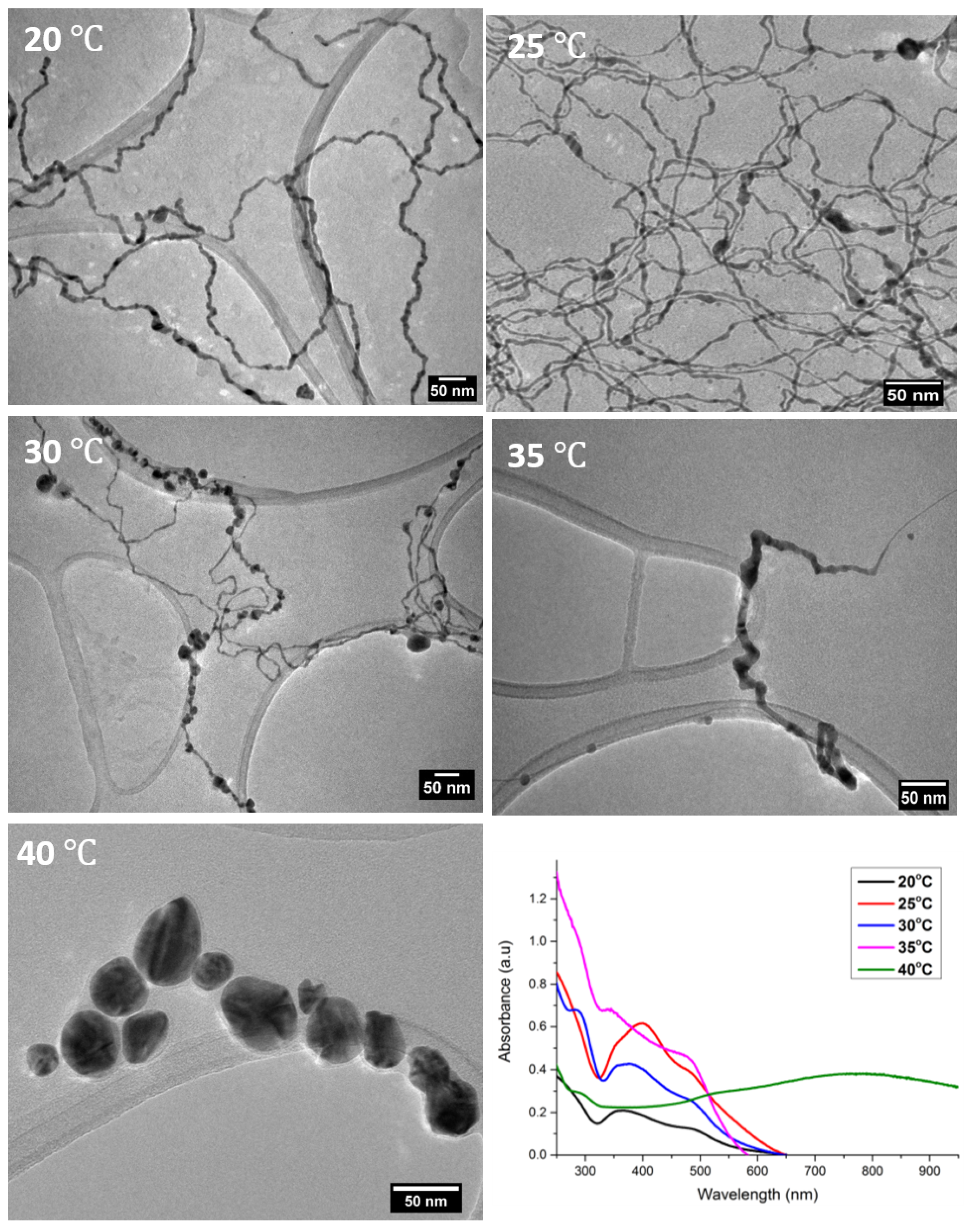
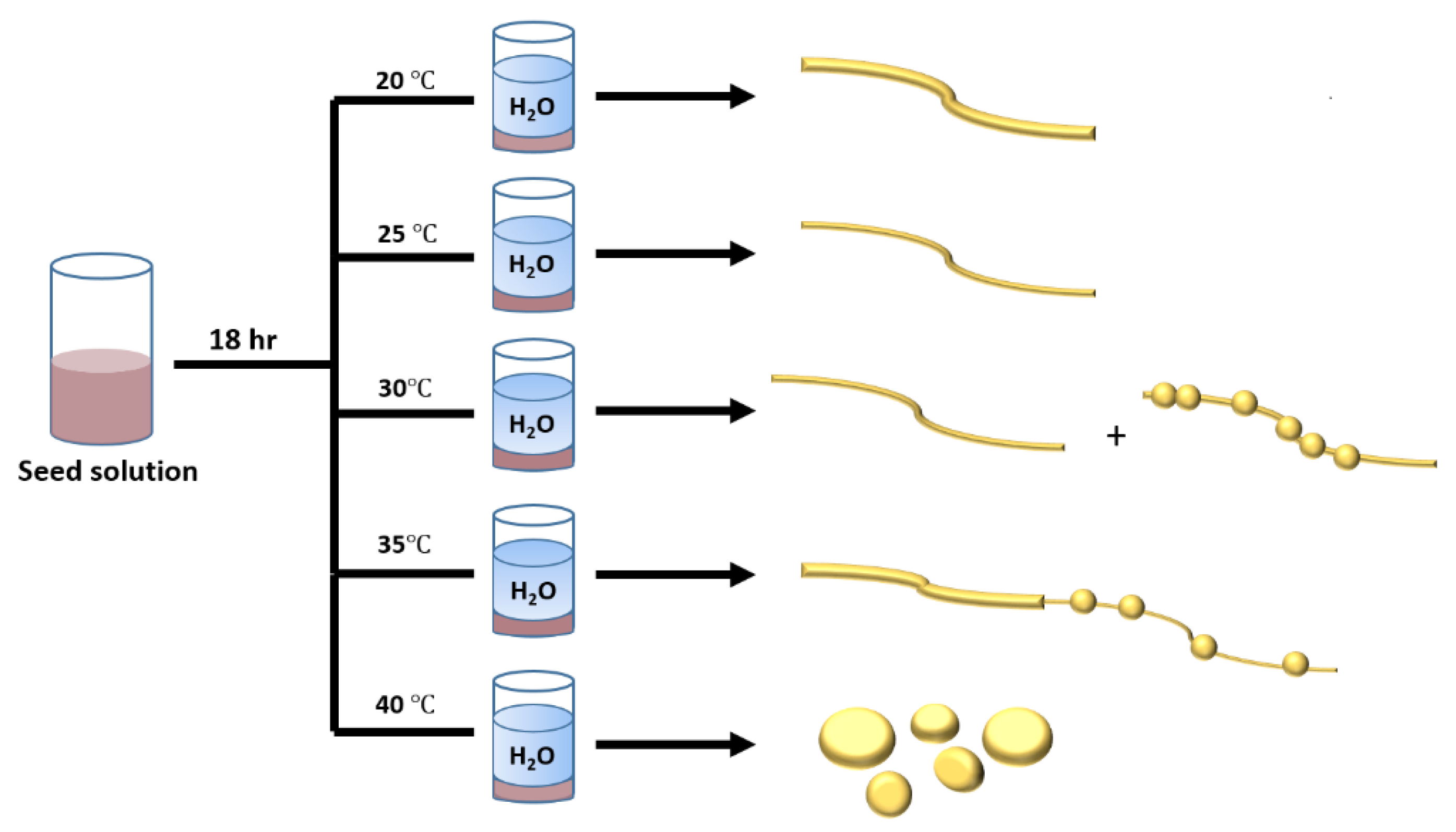
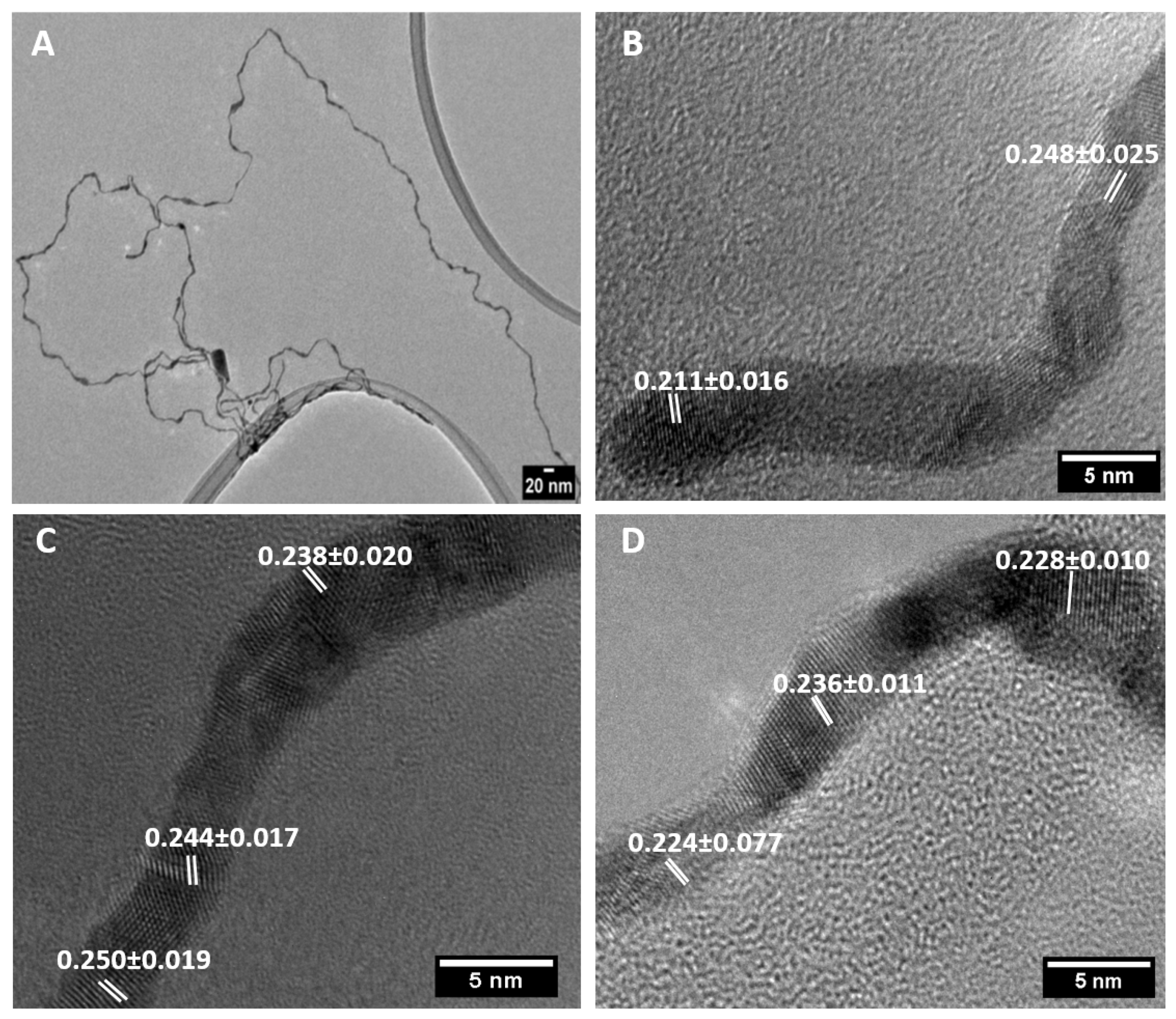
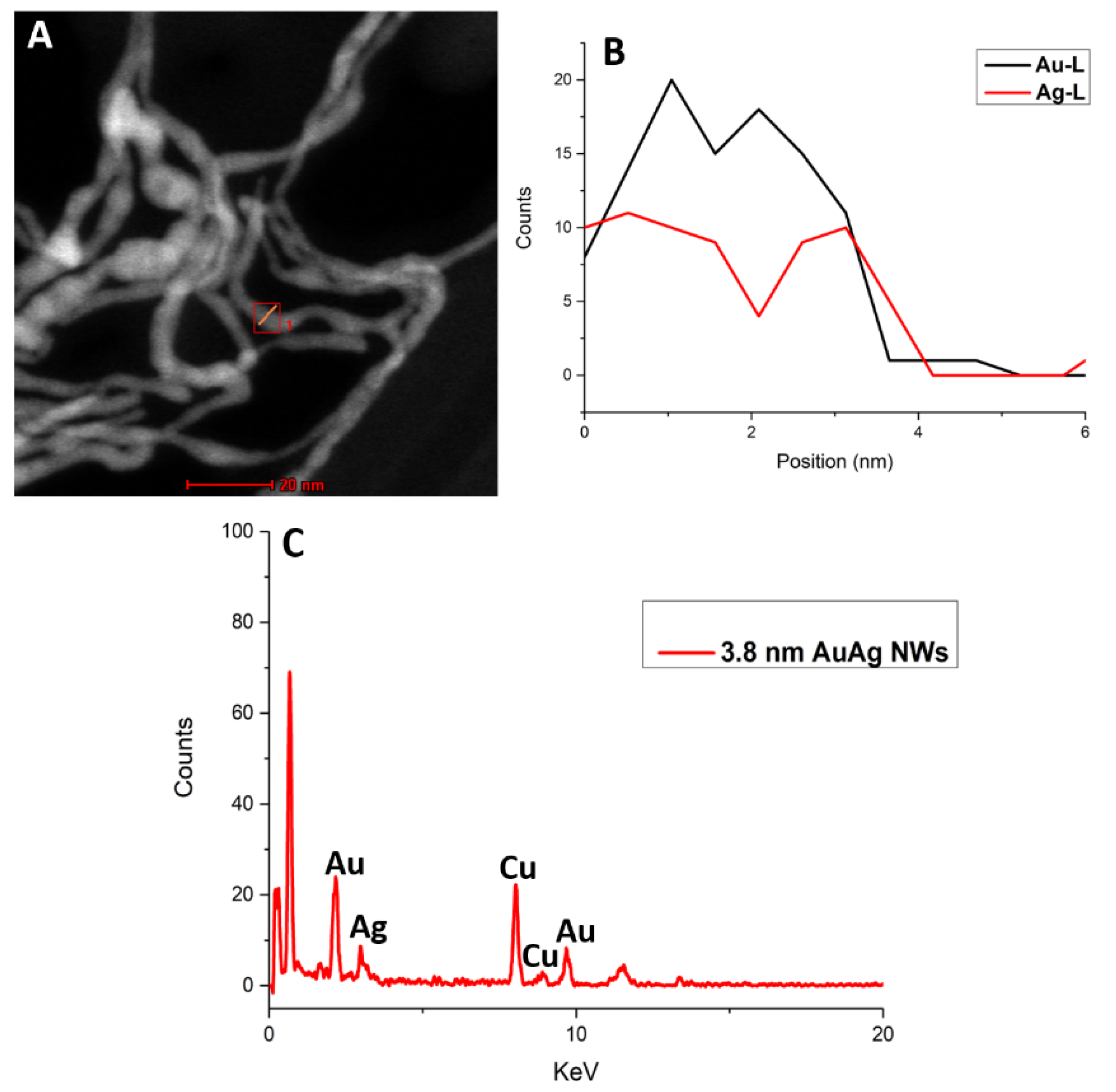
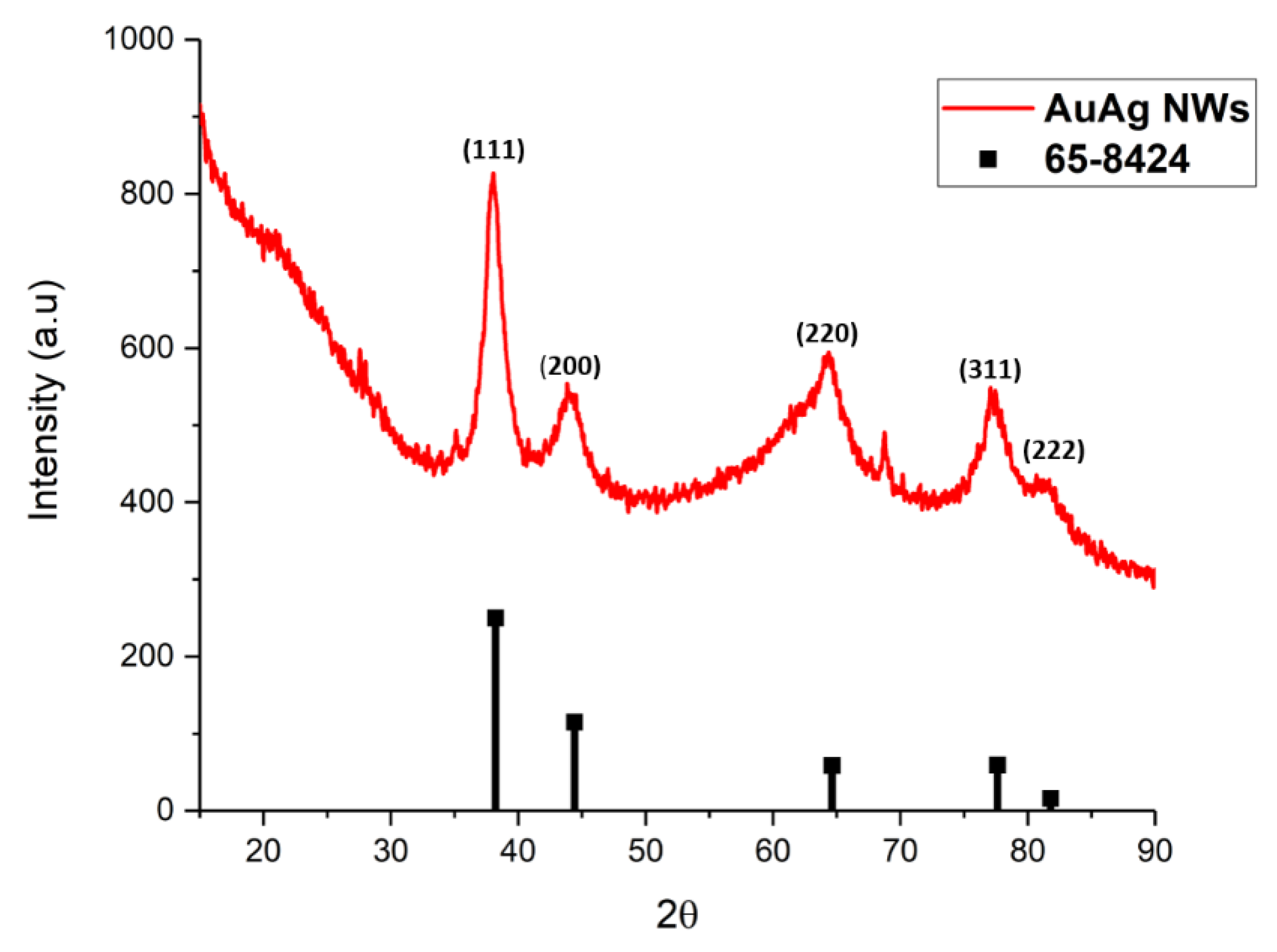
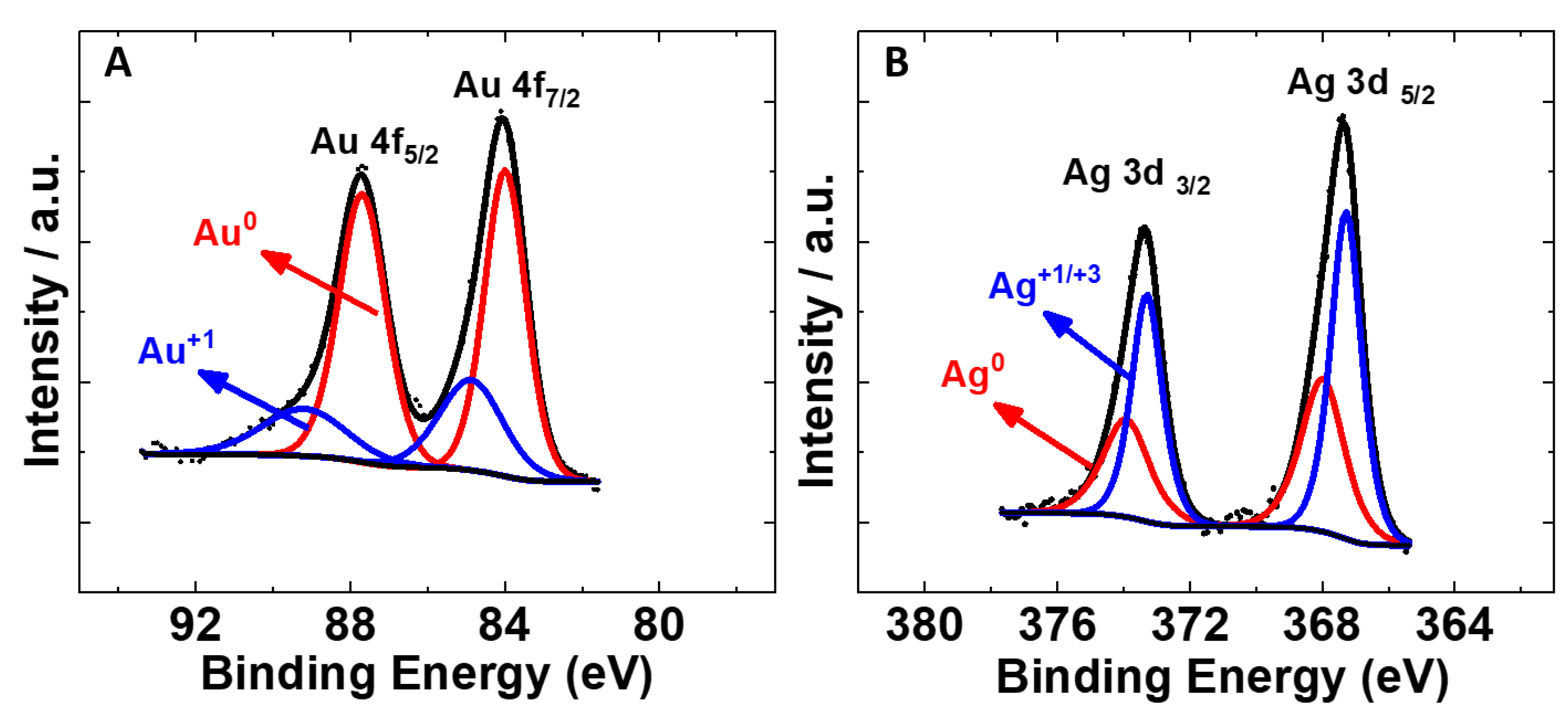
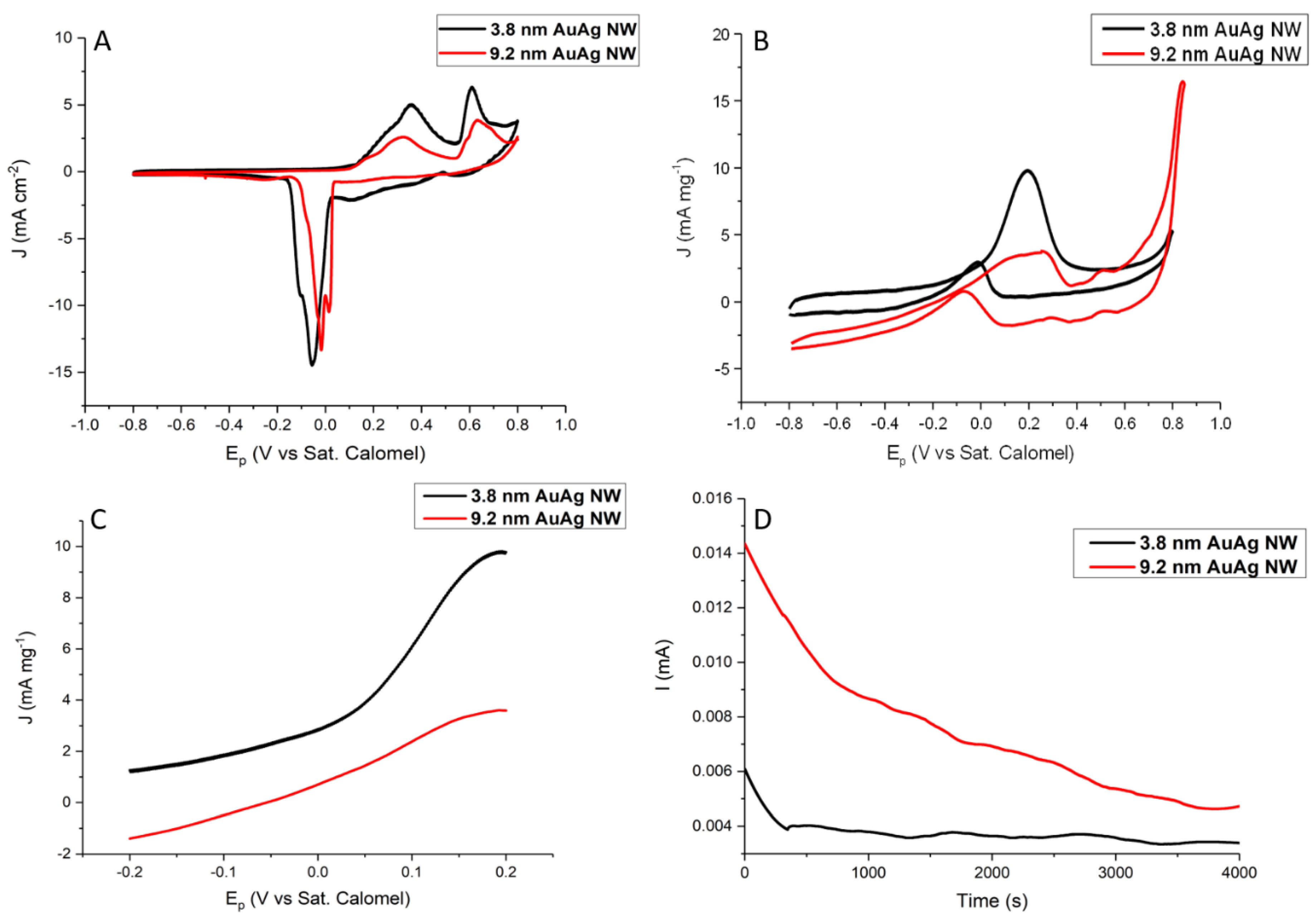
| Catalyst | Ep (V) | Jf/Jb |
|---|---|---|
| Au nanostars [24] | 0.2 (vs. sat. calomel) | 3.71 |
| AuPd@Pd nanocrystals [86] | ca. −0.7 (vs. sat. calomel) | 2.41 |
| Au nanocrystals [86] | ca. 0.3 (vs. sat. calomel) | 2.31 |
| AuPd NW networks [29] | ca. 0.025 (vs. sat. calomel) | ca. 0.8 |
| AuPd Nanoflowers [79] | ca. −0.01 (vs. sat. calomel) | ca. 0.75 |
| Hollow AuAg1Cu1 nanoflowers [87] | −0.22 (vs. sat. calomel) | ca. 2.6 |
| 3D Au33Cu67 ultrathin NW network [51] | ca. 0.3 (vs. sat. calomel) | ca. 4.2 |
| PdAuRu nanocrystals [88] | −0.1 (vs. sat. calomel) | ca. 1.92 |
| Open bowl-like Pt1Au1Ag1 nanocages [19] | ca. 0.6 (vs. sat. calomel) | ca. 4.7 |
| 3D Pt5.7Pb ultrathin NW networks [89] | ca. −0.1 (vs. sat. calomel) | ca. 5.7 |
| Pt31Cu69 NWs [90] | −0.1 (vs. sat. calomel) | ca. 1.97 |
| Screw-like PtPd NWs [91] | ca. 0.1 (vs. sat. calomel) | ca. 0.842 |
| Pt1Co1 NWs [92] | ca. 0.505 (vs. sat. calomel) | ca. 1.26 |
| AuAg NWs (9.2 nm) (this work) | 0.22 (vs. sat. calomel) | 1.7 |
| AuAg NWs (3.8 nm) (this work) | 0.193 (vs. sat. calomel) | 3.2 |
© 2020 by the authors. Licensee MDPI, Basel, Switzerland. This article is an open access article distributed under the terms and conditions of the Creative Commons Attribution (CC BY) license (http://creativecommons.org/licenses/by/4.0/).
Share and Cite
K. Kehoe, D.; Romeral, L.; Lundy, R.; A. Morris, M.; G. Lyons, M.; Gun’ko, Y.K. One Dimensional AuAg Nanostructures as Anodic Catalysts in the Ethylene Glycol Oxidation. Nanomaterials 2020, 10, 719. https://doi.org/10.3390/nano10040719
K. Kehoe D, Romeral L, Lundy R, A. Morris M, G. Lyons M, Gun’ko YK. One Dimensional AuAg Nanostructures as Anodic Catalysts in the Ethylene Glycol Oxidation. Nanomaterials. 2020; 10(4):719. https://doi.org/10.3390/nano10040719
Chicago/Turabian StyleK. Kehoe, Daniel, Luis Romeral, Ross Lundy, Michael A. Morris, Michael G. Lyons, and Yurii K. Gun’ko. 2020. "One Dimensional AuAg Nanostructures as Anodic Catalysts in the Ethylene Glycol Oxidation" Nanomaterials 10, no. 4: 719. https://doi.org/10.3390/nano10040719
APA StyleK. Kehoe, D., Romeral, L., Lundy, R., A. Morris, M., G. Lyons, M., & Gun’ko, Y. K. (2020). One Dimensional AuAg Nanostructures as Anodic Catalysts in the Ethylene Glycol Oxidation. Nanomaterials, 10(4), 719. https://doi.org/10.3390/nano10040719








